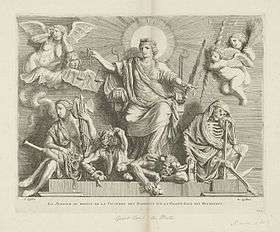Hubertus Quellinus

Hubertus Quellinus or Hubert Quellinus (August 15, 1619, Antwerp – 1687) was a Flemish printmaker, draughtsman and painter and a member of the prominent Quellinus family of artists. His engravings after the work of his brother, the Baroque sculptor Artus Quellinus the Elder, were instrumental in the spread of the Flemish Baroque idiom in Europe in the second half of the 17th century.
Life and work
Hubertus Quellinus was born into a family of sculptors and painters, which included, amongst others, his father Erasmus Quellinus the Elder and his brothers, the Rubens pupil Erasmus Quellinus the Younger and the prominent sculptor Artus Quellinus the Elder.[1] In 1650 he traveled to Rome where he joined the Bentvueghels, an association of mainly Dutch and Flemish artists working in Rome. It was customary for the Bentvueghels to adopt an appealing nickname, the so-called 'bent name'. Hubertus was given the bent name Saracin.[1]

Quellinus was in Amsterdam by 1660 where he collaborated on a publication, which consisted of two parts: the first part consisted of 30 plates depicting the Amsterdam City Hall after designs made by Jacob Vennekool and engraved by Dancker Danckerts while the second part of the publication in two volumes included prints after the marble statues and ornaments executed by Artus Quellinus the Elder in the Amsterdam City Hall. The designs for these prints in the second part were made and engraved by Hubert Quellinus and were marked with the initials of both Artus (A. Q) and Hubertus Quellinus (H. Q). The two parts formed a volume in folio.[2][3] The first part was published initially in 1655 while the second part was first published in 1663 in Amsterdam but the publisher Frederick de Widt (or 'de Witt') changed the dates on the Quellinus prints to 1665 and 1668.[4] The publication was instrumental in the spread of the Baroque style in Northern Europe until the end of the 17th century, and was used by nearly all followers of the Flemish Baroque style in Europe as the most important pattern-book and source of inspiration in the fields of architectural ornamentation and sculpture.[5]
Quellinus also engraved some portraits and is known for a few history paintings.[1]
References

- 1 2 3 Hubert Quellinus at the Netherlands Institute for Art History (Dutch)
- ↑ Afbeelding van 't stadt huys van Amsterdam : in dartigh coopere plaaten (Images of the City Hall of Amsterdam in 30 copper plates), by Jacob van Campen & drawings by Jacob Vennekool; followed by De voornaemste statuen ende ciraten vant konstrijck stadthuys van Amstelredam, tmeeste in marmer gemaeckt door Artus Quellinus (The main statues and ornaments of the Amsterdam City Hall mostly made in marble by Artus Quellinus, Amsterdam, Frederick de Widt (or Witt), 1665.
- ↑ Afbeelding van't Stadt Huys van Amsterdam… [TASMAN] CAMPEN, Jacob Van. Amsterdam: Dancker Danckerts, 1661, at Hordern House
- ↑ Details of sculptural ornament by Artus Quellinus in the Courtroom of Amsterdam Town Hall: two Medusa heads and an all-seeing eye at Worcester College, Oxford
- ↑ Michał Wardzyński, Flemish Trend in Schleswig-to-Königsberg Baroque Sculpture in Marble and Stone in the Second Half of the 17th Century , in: Polish Baroque, European Contexts, Proceedings of an International Seminar held at The Institute for Interdisciplinary Studies “Artes Liberales”, University of Warsaw, June 27-28, 2011, p. 229-256
| Wikimedia Commons has media related to Hubertus Quellinus. |